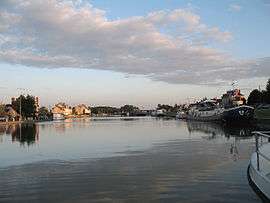Canal latéral à la Loire
| Canal latéral à la Loire | |
|---|---|
|
The port on the canal at Marseilles-lès-Aubigny | |
| Specifications | |
| Length | 196.1 km (121.9 mi) [1] |
| Locks | 37 [1] or 38 [2] |
| History | |
| Construction began | 1827 |
| Date completed | 1838 |
| Geography | |
| Start point | Canal de Briare at Briare |
| End point | Canal du Centre at Digoin [2] |
| Beginning coordinates | 47°37′55″N 2°44′12″E / 47.63197°N 2.73671°E at aqueduct crossing Loire in Briare |
| Ending coordinates | 46°28′39″N 3°58′50″E / 46.47756°N 3.98053°E at aqueduct crossing Loire in Digoin |
| Branch(es) | Embranchement de Châtillon |
| Connects to | Canal de Briare, Canal du Centre |
The Canal Latéral à la Loire was constructed between 1827 and 1838 to connect the Canal de Briare at Briare and the Canal du Centre at Digoin, a distance of 196 km. It replaced the use of the River Loire which had reliability problems arising from winter floods and summer droughts. Aqueducts were used to cross the River Allier at Le Guétin (in the commune of Cuffy) and the River Loire at Digoin, but because of the extreme length required, one was not built to cross the Loire River at Briare until 1896 when the Briare aqueduct was constructed.
History
By the late 18th century with the completion of the Canal du Centre, the Bourbonnais route from the Seine to the Saône was substantially the same as at present, except for the use of the navigable Loire between Briare and Digoin. The introduction of steam haulage and dredging failed to produce the reliability of the canals, so it was in 1822 that the order to build was finally given to the Compagnie des Quatre Canaux. Although the original intention was to place the canal on the right bank, the towns of Nevers, la Charité and Cosne had no room for a canal and eventually construction started in 1827 on a canal on the left bank. Two massive stone aqueducts were built at Digoin and at Guétin to avoid level crossings of rivers with length 243m and 470m respectively, but this was not possible at Briare because of the danger of blocking the river during flood periods.
With the adoption of the Freycinet gauge in 1879, and the upgrading of the canal system, the frequent delays of several days to cross the Loire at Briare became intolerable and a 662m steel aqueduct was built across the Loire to connect to the Canal de Briare by Abel Mazoyer. This is part of the Canal Latéral à la Loire, not the Canal de Briare.
En Route

- PK 198 Briare
- PK 198 Briare aqueduct
- PK 192 Châtillon-sur-Loire
- PK 187 left to Châtillon branch canal for access to Loire river [2]
- PK 180 Belleville-sur-Loire
- PK 175 Léré
- PK 159.5 Saint-Satur or Saint-Thibault
- PK 143 Herry
- PK 125 Marseilles-lès-Aubigny
- PK 100 Nevers
- PK 68.5 Decize
- PK 53 Gannay-sur-Loire
- PK 41 Garnat-sur-Engievre
- PK 29 Dompierre-sur-Besbre right canal branch to Dompierre-sur-Besbre
- PK 15 Coulanges
- PK 4 Digoin
- PK 0 continues as Canal du Centre

See also
References
External links
| Wikimedia Commons has media related to Canal latéral à la Loire. |
